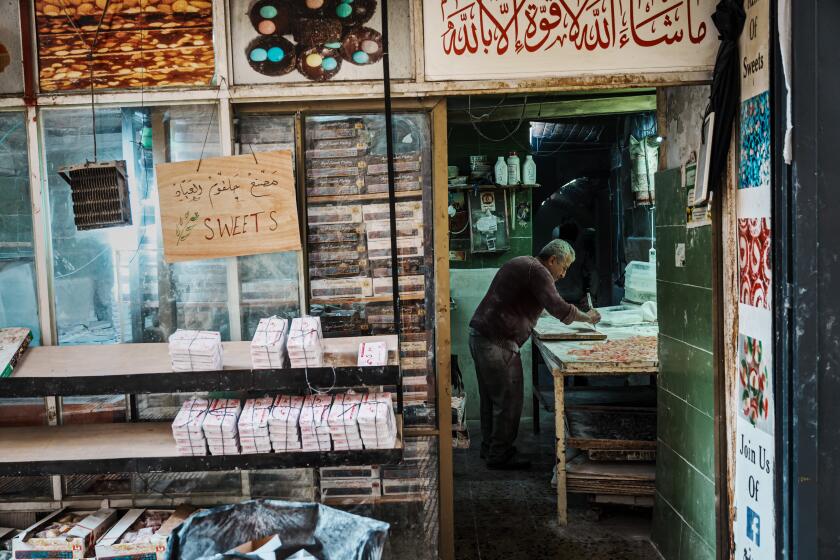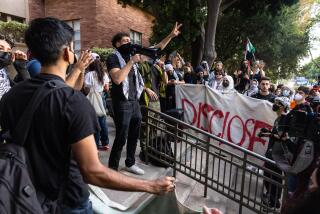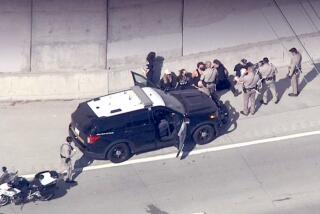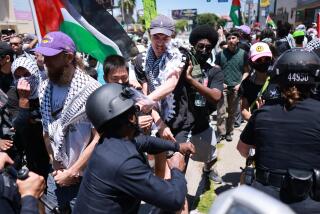Shutting a freeway in traffic-clogged L.A. gets attention. But is it effective activism?
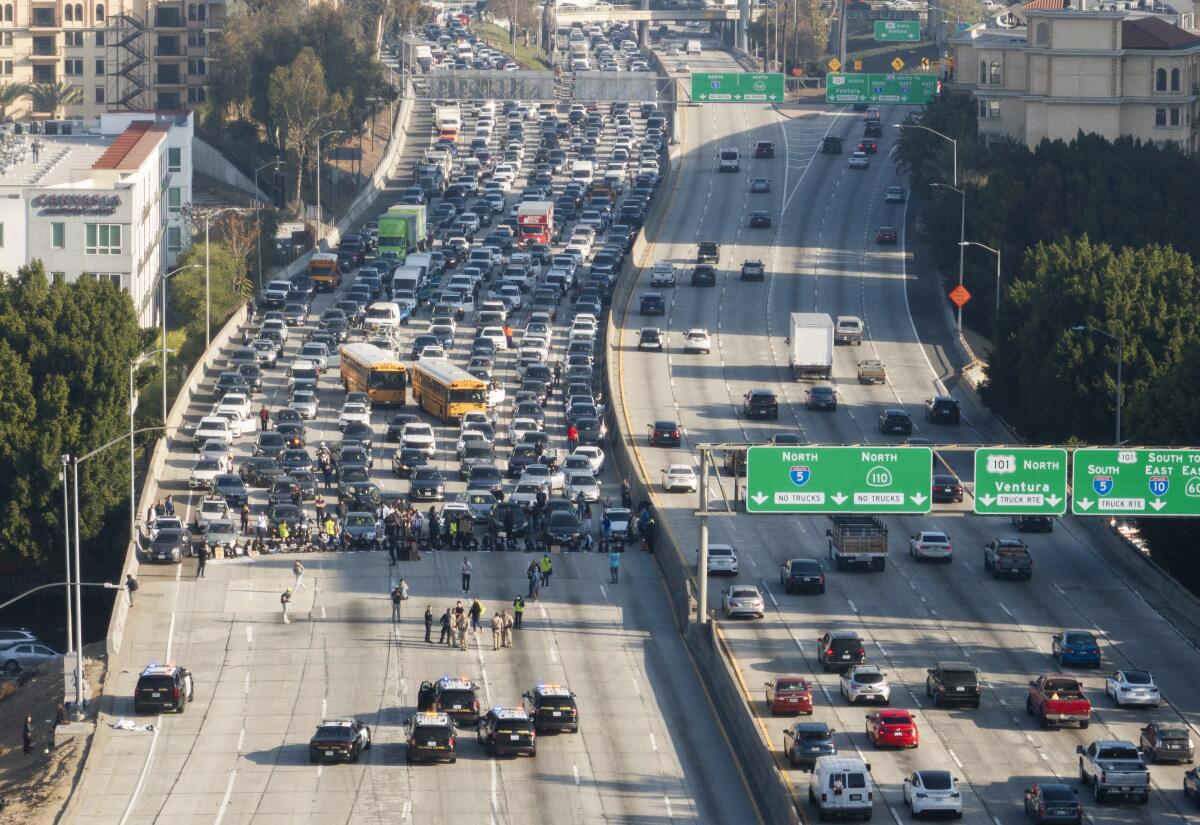
A son on the way to the airport to say goodbye to his dying father watched time slip by. A mom comforted her hungry infant. And employees were late for work.
Frustration generally boiled over earlier this week as protesters calling for a cease-fire in Gaza halted traffic for hours along a downtown Los Angeles freeway during morning rush hour.
A month earlier in the Bay Area, a protest demanding the same thing shut down the Bay Bridge for hours — and delayed needed transplant organs. And on one of the busiest travel days of the year, the Sunday after Thanksgiving, a group called Jewish Voice for Peace, shut down the Manhattan Bridge snarling traffic. On Thursday, that group and other allies shut down major roads and bridges in several major cities including Philadelphia and Washington.
Freeways and bridges are the lifelines of America’s big cities. And protesters of everything from climate change to police brutality have known for years there is no better way to get people’s attention than to interrupt those corridors of daily life, even if they elicit as much anger as they do sympathy.
It’s unclear if their message is winning any converts.
Videos captured on the 110 Freeway showed drivers shouting at activists. One motorist grabbed a protester by the collar and threw them on the hood of a car while others laughed and recorded the brawl.
“The situation was tense and you could feel it from both sides,” said photographer Johnny LaVallee. He had been on his way to an assignment near downtown when traffic came to a standstill.
“Some people who were stuck in traffic even told me that they didn’t even know what was going on in Gaza. This guy looked at me like I was crazy and said, ‘I don’t watch the news. I’m just trying to get to work.’”
Nowhere do these standoffs strike the heart of a city like they do here. Freeways are touchstones to the story of modern Los Angeles: The division of historic neighborhoods in Boyle Heights and South L.A. The collapse of the I-10 during the Northridge earthquake. The O.J. Simpson chase down the 405. Carmageddon. The traffic jams in movies from “LaLa Land” to “Falling Down.”
It’s why nearly 20 years ago big rig truckers protesting fuel costs parked on the 5 Freeway during morning rush hour, backing up traffic for at least seven miles. It played into demonstrators’ decision to walk onto the 101 Freeway in 2020 to protest the murder of George Floyd and to close the 10 Freeway in 2013 to decry the acquittal of George Zimmerman in the killing of Trayvon Martin.
At peak hour, 17,200 commuters drive the 110 Freeway that goes through downtown and connects some of the busiest routes in the city — the 405, 105, 101 and 5 freeways.
Protesters drove their cars onto the congested 110 where traffic was crawling. They stopped on the freeway and got out of their cars near Beaudry Avenue to form a human chain across the highway. Others farther back in traffic stopped and ran forward to join.
As a protest calling for a cease-fire in the Gaza Strip blocked southbound traffic on the 110 Freeway in downtown Los Angeles, video footage showed angry motorists skirmishing with demonstrators.
Experts say targeting major transportation routes can be both incredibly powerful and extremely risky.
“You are guaranteed that millions of people are going to hear about your protests, because everybody listens to the traffic report,” said Michael Beer, director of Nonviolence International, a group that supports nonviolent actions and trains protesters. “It’s very hard to cut through the media environment, unless you engage in a disruptive action, particularly around transportation.”
“But you have to think: Are you stopping the ambulance from getting to a hospital and somebody’s gonna die?” he said. “You don’t want your protest to be damaged by not thinking something through and somebody dies indirectly because of protest.”
But, he said, it has happened in protests around the world.
Organizers were apologetic after stopping vehicles on the southbound 110 Freeway and snarling traffic around it for hours, but they were pleased that the stark images of an empty freeway and their message played out on local television stations and grabbed headlines around the world.
“We understand that engaging in a disruption like this has material consequences for people’s commute and their daily life, “ said Adam Hirsch, an organizer with IfNotNow, the progressive Jewish group behind the protest. “We’re sorry for people that were impacted negatively in that way.
“But at this point, we really have no choice but to take this kind of disruptive action,” he said. “We have to kind of shove a wedge into the public consciousness in order to demonstrate the fact that this is an immense, immense moral crisis, not just for Jewish Americans, but for every single American because our tax dollars are funding this war.”
Over 1,200 people were killed on Oct. 7 when Hamas launched its attack against Israel, according to Israeli officials. But since then, over 18,000 Palestinians trapped in Gaza were killed in unrelenting airstrikes and ground attacks by Israeli forces, according to Gaza’s Ministry of Health. The U.S. has been a key Israeli military ally.
Israeli military raids and settler attacks in the occupied West Bank are costing the Palestinian economy $25 million a day, just ask the sweets makers.
Despite the scuffles captured on video, what Hirsch described as a few “isolated incidents” on the freeway that were “defused,” he said most people have shown support for the group.
“We have received an overwhelming amount of positive feedback about the message and impact of our action and we hope that inspires others to take up acts of nonviolent protest so that we can achieve a lasting ceasefire,” he said.
For more than two hours the scene unfolded. Motorists pleaded with the protesters to clear a path, shouting at the group blocking the seven-lane highway. “Let us work. We want to work,” a man shouted, beating the palm of his hand against his chest in a video LaVallee recorded.
“I photographed a mother who was holding her infant child and who didn’t have any food to feed the baby. I met a man who was on his way to catch an international flight to go say goodbye to his dying father,” LaVallee said.
He said he supports the right to protest, “but I feel like blocking traffic during rush hour in Los Angeles is 99.9% always unnecessary.”
Those who study movements say that organizers need to be thinking about the narrative — what that message is and how it is being delivered.
“There were just a lot of working-class people who were upset about not being able to get to work or take their kids to school, and that’s probably not engendering a lot of goodwill for the protesters,” said Manuel Pastor, director of the USC Equity Research Institute.
Effective protests create a narrative about the issue, one that resonates with the protest, and he’s not sure that people are making the right links in their mind.
“When poor truckers block the freeway, you might think, ‘Well, those are some hard-working people using the only tools they’ve got,’” he said. George Floyd protests came at a moment when “there was a lot of attention on racial inequity, a lot of empathy or sympathy for that cause.”
“This didn’t necessarily have that same feeling, where you can have an immediate and visceral connection as a commuter to the issue,” he said.
Still, he understands the pure frustration among organizers. “There’s a huge crisis in Gaza,” he said, “and it’s slipping off the front page.”
The tactic is largely geared toward media, who can amplify the objecters’ message.
“Journalists typically don’t cover protesters that behave themselves, especially if they’re relatively small, so the point of this tactic is to make sure you get that attention,” said Jay Ulfelder, research project manager at Harvard’s Nonviolent Action Lab. And the protesters involved likely put themselves at great personal risk.
A lot of tactics carried out during the Civil Rights Movement was exactly this type of thing, he said. “And at the time, people hated it.”
More to Read
Sign up for Essential California
The most important California stories and recommendations in your inbox every morning.
You may occasionally receive promotional content from the Los Angeles Times.

